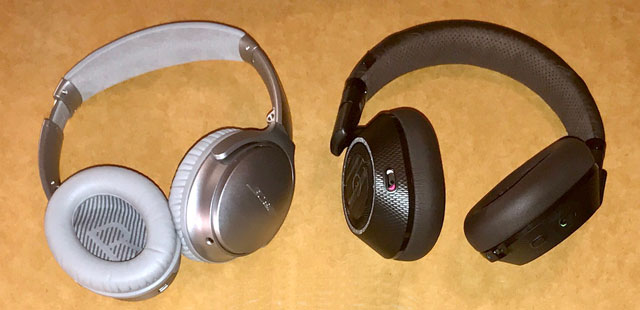
Bose QuietComfort 35 on the left, Plantronics BackBeat Pro 2 on the right
For frequent travelers, noise-canceling headphones are de rigueur. Now, you can choose from high-quality Bluetooth options like the over-ear Plantronics BackBeat Pro 2 headphones ($199 on Plantronics.com) or the Bose QuietComfort 35 ($349 on Amazon). How do they compare? We listened to both for a few days to find out.
Based simply on price, the Plantronics BackBeat Pro 2 are a comparative steal. Not only are they $100 to $150 cheaper than the Bose alternative (and about the same price as the first-generation BackBeat Pro headphones, $194.95 on Amazon), but they offer five features not found on Bose QC35 headphones.
- Sensors automatically pause music play when you take the BackBeat Pro 2s off your head or even shift one of the ear cups off your ear. They automatically start to play again when you put them back where they belong to start listening again.
- The BackBeat Pro 2s operate equally well with the active noise-cancelling on or off, a carry-over from the original BackBeat Pro headphones. The Bose QC35 headphones, however, automatically use active noise-cancellation when they're powered on. (Both headphones can operate like normal, non-powered headphones when you use the included cable.)
- The BackBeat Pro 2s give you 24 hours of listening with active noise-cancelling activated; the Bose headphones give you just 20 hours. The BackBeat Pro 2s enter a six-month DeepSleep hibernation to preserve battery life if you leave them on.
- If you want to leave the BackBeat Pro 2s on your ears but still want to hear what's happening around you, slide the active noise-cancelling switch up to activate an external microphone and pause your music. You won't get sound as loud as taking off the headphones to hear, but you'll hear enough without activating the sensors.
- If you're conducting simultaneous live and phone conversations, there's a mute button on the right ear cup, which I guess you'd use in conjunction with the open mic button to continue conversing with the real people around you.
Ergonomically, the BackBeat Pro 2s are 35 percent smaller than their bulky predecessor, as well as 15 percent lighter. They use oval rather than round ear cups. No longer far bulkier than the Bose headphones, as the first-generation BackBeat Pros were, the BackBeat Pro 2s are now barely larger and heavier than the QC35s.
Noise cancelling and sound quality
To test the sound quality and active noise-cancelling capabilities of these two headphones, I ran a YouTube Airbus 320 cabin hum video at around 85db, the average noise level in an airplane cabin while cruising. After many back-and-forth comparisons, I found the QC35s did a slightly better job than the less expensive BackBeat Pro 2s. I'm not sure the slight active noise-cancelling improvements of the QC35 headphones are worth $100 to $150, considering the loss of the BackBeat Pro 2s' other advantages. I found even less difference between their performance in either active noise-cancelling or passive modes when I used the included cable.
The Plantronics BackBeat Pro 2s are the best value of these two over-ear Bluetooth, active noise-cancelling options. Be sure to check out our pick for the best corded noise-cancelling headphones, the Philips Fidelio NC1 ($299.99, now discounted to $179.99 on Amazon), which beat out the corded Bose QuietComfort 25s.
[Image credit: Stewart Wolpin/Techlicious]

















